This past week, the head of the RCMP finally admitted that there was institutional racism in the force, just days after claiming “we don’t have systemic racism,” in spite of years of evidence to the contrary. The last few weeks alone have shown overwhelming proof of the RCMP’s systematic assault on Canadian racial minorities: the murder of two Indigenous people, Chantel Moore and Rodney Levi, only eight days apart in New Brunswick; video of the assault on Chief Allan Adam in Alberta; and video of the open door of a moving RCMP vehicle hitting an Inuk man and then five cops manhandling him in Nunavut.
The Canadian protests sparked by the murder of George Floyd in Minneapolis are also about the racism of the Canadian state as shown by the RCMP and other police forces. As crisis after crisis continues to plague 2020, the fury over the murder of George Floyd has been a spark to the powder keg of economic uncertainty, cabin fever, and pandemic anxiety catalyzed by COVID-19. While the current Black Lives Matter (BLM) iteration of the civil rights movement has been burning steadily since 2014, these global protests have a different timbre to them.
The Washington Post compared the recent protests over George Floyd’ s murder to the most recent protest movement of a similar size, the 2017 Women’s Marches after Trump’s inauguration, that took place in 650 US locations. The George Floyd-inspired protest has included thousands of marches, with protests in all 50 states, including in hundreds of smaller, lesser-known towns and cities that have not been in the spotlight during previous nationwide protests. The United States rarely has protests in this combination of size, intensity and frequency; it usually has big protests or sustained protests, but not both. This outburst feels unique because it is. Pennsylvania, the most closely researched example, has seen “multiracial protests led by young local black activists—often people who have been organizing around the label and issue of Black Lives Matter for years—joined in the streets by white and Latino young people in ways and numbers they have never seen before.”
This police murder of an unarmed black man has caused the pendulum to swing from BLM as a highly supported but sparsely protested cause, especially among whites, to an all-encompassing global movement, marked by a shift from “not racist” to “anti-racist,” with inspiring determination.
Canadians held protests across the country, dwarfing any previous BLM demonstrations. For example, Vancouver held two protests, on May 31 and June 5. The May 31 protest was attended by an estimated 3,500 people. The square in front of the Vancouver Art Gallery was packed, with the crowd extending across Georgia Street and into the other nearby streets. Tons of people brought signs bearing anti-racist and anti-police-brutality slogans, and the mood was upbeat, with enthusiastic chants of “black lives matter,” and “no justice, no peace,” among others. There were also Indigenous speakers, who led the crowd in the singing and chants.
The June 5 protest crowd was estimated between 5,000 and 10,000, with the whole of Jack Poole Plaza packed and overflowing onto the streets. Organizers gave out water, masks, supplies for signs, and even pre-made signs. Speakers shared their experiences with racism, calling for both resistance and revolution.
This enthusiasm and energy for protest has extended beyond major black communities in Toronto, Montreal, Ottawa, Edmonton and Calgary. Alberta, arguably Canada’s most right-wing province, had at demos in at least eleven cities and towns – many the largest for years on any issue.
Grande Prairie, a small city of just over 60,000 in northwestern Alberta has a reputation as an oil town, with a large majority of people supporting that industry. It is often described as a right-wing city. Grande Prairie is 76% white, 13% First Nations, and 11% visible minorities (mainly from the Philippines), including 2% black. The June 6 rally’s location was moved to accommodate the unexpected amount of interest. Over 600 people attended, many of whom held BLM signs with famous quotes of various popular civil rights leaders. The rally had four speakers who connected the massive protests in the United States and the growing fight for justice and against racism in the United States with the same struggle in Canada, and Grande Prairie in particular. They spoke of their experiences as people of colour in Grande Prairie and the particular difficulties it had caused them throughout their lives. The final speaker was an older man who moved to Grande Prairie from South Africa in 1999. To an enthusiastic and increasingly raucous crowd, he spoke of his struggle with apartheid, and of his experiences with racism in Grande Prairie. His speech was followed by loud applause after which the crowd began walking down the main street and chanting common BLM slogans.
The Maritimes had at least eight protests, showing the coast-to-coast enthusiasm for not only justice for George Floyd, and other minorities killed by police across North America, but a cross-racial solidarity unseen in recent years. This included a large protest in Charlottetown, police estimate around 10,000, which is notable considering the city’s small size (~37,000) and demographic makeup (85% white and only 1.4% black). Iqaluit, Yellowknife, Dawson City and Whitehorse joined in, covering the longitude and latitude of the country with shows of support.
One question that pundits, politicians, and provocateurs alike have been asking about the spontaneous global protest movement is: why do people from Senegal, Sri Lanka, Turkey, Finland, Jamaica, and nearly everywhere in between care about the plight of one man in Minneapolis? Bad faith of this question aside, along with global solidarity, the reason behind these protests is a general recognition of state and police abuses of power, filtered through each nation’s unique lens. For Canadians, this is a reckoning with the unfolding of colonialism, particularly authoritarian municipal police forces and the modern day colonial RCMP, as demonstrated by the murder of Black and Indigenous people.
Policing issues in Canada are often treated with the same “at least we’re not America” attitude bountiful in Canadian consciousness. In this case, that attitude is nothing more than blind delusion. Systemic racism is replete in our police forces, exemplified in the process of “carding,” street ID checks when no particular offence is being investigated. In Toronto, Black people are carded roughly three times more often than average, while in Vancouver, Black people are carded roughly four times more often than average, while Indigenous people are carded at a rate more than seven times higher than average.
Other Canadian policing issues include routine suppression of racial police data by police departments, and the horrifyingly infamous “starlight tours,” in which Saskatoon police would arrest Indigenous men and women, drive them out beyond the city limits, and leave them there, in the middle of winter. In April 2020, Winnipeg police killed three Indigenous people in ten days. Canadian police departments are no less systematically racist than their American counterparts, and white Canadians unwilling to confront this fact only perpetuate our nation’s ongoing history of white supremacy.
Along with the global nature of these protests, another theme that has arisen is the role of Generation Z at or near the head of this movement. Youth are taking a role at the forefront of protest unseen in decades, from Greta Thunberg and the other young people leading 2019’s climate marches, to the Parkland school shooting survivors pushing back against the National Rifle Association in the American gun control debate.
Generation Z is radicalized, and ready to fight for a better future, because they are under no illusions, and can already recognize that the world doesn’t, and won’t, belong to them, without a serious fight. State powers are aware of this generational unrest, to the point that the Pentagon ran war games envisioning a Gen Z uprising. The “zoomers” are here to stay, and the powers that be have been put on notice. The George Floyd protests are more likely to become a trend than an outlier, as more and more crises of capitalism begin to clash in the coming months, years, and decades.
On the surface, the scope and breadth of Canada’s protests are against George Floyd’s murder and the racism of Canada’s police and legal system. However, the energy is part of much deeper desire for change, pressure cooked by COVID-19. Premier Legault of Québec claimed that “there is no systemic discrimination in Quebec,” while in Ontario Doug Ford stated that racism in Canada does not have “systemic, deep roots.” Trudeau, ever keen for a cheap photo-op instead of action, took a knee in Ottawa. Change will not come from the head of the RCMP or our present politicians. It will take mass pressure and protests.
Socialist Alternative demands include:
- “Defund” the police and Re-fund public services: Cut police budgets by 50% and direct that money to support mental health, community services, addiction services and building social housing.
- Community control over public safety: Democratic control over the police with community say on policies and practices, budget, hiring, etc.




